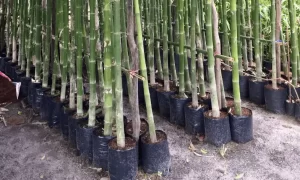How to Plant Bamboo- What You Need to Know: Bamboo has become a must-have for many garden owners. And this is absolutely understandable. But to avoid unpleasant surprises, every bamboo lover should know how to plant this giant grass. In this article, we answer the most important questions about the topic and give you helpful professional tips on how to plant bamboo.
Contents
- Does Bamboo Always Need a Root Barrier?
- 1. With spreading urge:
- 2. Without a tendency to spread:
- How to Place an Effective Root Barrier
- How and When to Plant Bamboo?
- The right place to plant bamboo
- Planting Bamboo is Not Witchcraft!
- Planting Bamboo Hedges
- Final Pieces of Advice: How to Plant Bamboo
- What is the best way to plant bamboo?
- How do you plant a bamboo stalk?
- Why is it illegal to plant bamboo?
- Can you overwater bamboo?
Does Bamboo Always Need a Root Barrier?
One characteristic that discourages many garden owners from planting bamboo is its urge to spread. It must be said, however, that this characteristic does not apply to every species. Here it is important to get detailed information before buying to avoid any nasty surprises. If you choose a screen bamboo, a root or rhizome barrier is not necessary. In the case of flat cane bamboo, on the other hand, it is essential to pull it around the root ball before planting.
A basic distinction is made between “1. Bamboo species with spreading urge” and “2. Bamboo species without spreading urge“.
1. With spreading urge:
This group includes all species of the bamboo genus Phyllostachys, as well as Sasa (Pleioblastus). They form underground root runners, some of which can grow up to 10 m long. It is due to this fact that everywhere in the garden more stalks suddenly shoot out of the ground. These can cause great damage after a few years.
Warning: Especially the ground-covering varieties of Sasa should under no circumstances be planted near other woody plants! Their root runners would intertwine with the roots of the neighbors.
2. Without a tendency to spread:
Here we can only mention the Fargesia bamboos. Unlike other species, Fargesia does not form root runners but maintains themselves through compact clumps. For this reason, you can also do without a root barrier when planting.
How to Place an Effective Root Barrier
It is important to know how to place a root barrier effectively. To prevent the uncontrolled spreading of Phyllostachys bamboo and other sprawling species, it is essential when planting these bamboo species to draw a sturdy plastic root barrier (not a thin pond liner!) around the root ball.
It is imperative that this is completely closed and that its diameter is such that the bamboo has room to develop for several years. Above, about 5 cm of the film should protrude from the soil and downward it must reach at least 60 cm deep. The two ends are connected with a special clamping rail because it can still well absorb a high root pressure without giving way.
Tips: Those who shy away from this effort can make it work with large plastic spittoons. Buried in the ground, they also keep the roots of these giant grasses in check!
How and When to Plant Bamboo?
The right place to plant bamboo
Choosing the right place to plant bamboo is important. Unfortunately, it is not possible to give general advice on the light conditions, as the requirements are sometimes very different depending on the species. Here it is advisable to look at the detailed description of the variety.
Common to all bamboo species is a preference for well-drained, sandy-loamy to humus-rich soils. Both dry and moist locations are tolerated. However, the latter must never lead to waterlogging! However, pure sandy soils are just as unsuitable as these soils are too heavy.
Tips: To prevent waterlogging directly, it is advisable to improve heavy soils by working in sand or special bamboo soil.
Remember: Planting sites protected from the wind are what bamboo likes best. Because of their great mobility, you should allocate a wind-protected place in the garden for the giant grasses. That way, any storms can’t snap off stalks.
Planting Bamboo is Not Witchcraft!
In the case of how to plant bamboo, the most important thing is to determine when to plant bamboo. The best time to plant bamboo is in the spring. However, plants sold in pots can be planted year-round during frost-free periods. However, for late planting dates, think about good winter protection. With it, you reliably protect the young and not yet rooted plant from freezing. If the bamboo is planted already in the spring or summer, it is necessary to pay attention to a continuous supply of water.
Tips: Instead of a planting hole, you better dig a planting trench. This will facilitate the subsequent work, because: Once the trench is ready, you only need to put all the plants in it at the right distance and fill the trench with soil. Last but not least, do not forget to water!
Before planting, you should water the bamboo thoroughly. To do this, remove the pot and place the plant – depending on its size – either in a bucket or a large feeding barrel with water. As a guide to the size of the planting hole: 1.5 times the size of the root ball of the plant. The planting hole bottom, as well as walls, must be sufficiently loosened to facilitate rooting. Make sure to plant the bamboo exactly as deep as it was in the pot before and press or kick the plant well. Follow up with another thorough watering. This will close the soil around the root ball and no voids will remain.
Read more about How to plant sugar cane?
Planting Bamboo Hedges
Since bamboo grows very quickly and is also evergreen, it is very suitable as a hedge plant. Already after a short time, the longed-for and above all permanent visual protection is achieved with the giant grasses.
Medium-sized bamboo varieties are best suited for this purpose. Fargesia bamboos have the advantage that they do not need a root barrier and can therefore be planted without much effort. They are also very easy to keep in shape by regular pruning.
Final Pieces of Advice: How to Plant Bamboo
Planting bamboo is not witchcraft as said earlier. You need to know properly how to plant bamboo. When planting the bamboo hedge, a certain distance should be kept between them. This will give the individual plants more space to develop well. The size of the plant pot at the time of purchase will give some guidance here. But of course, the time you are willing to invest until the bamboo is opaque also plays a role. When planting according to the given rule of thumb, it can be said that the desired condition will have developed no later than the third year of standing.
Learn more about What do plants need to grow?
Frequently Asked Questions
What is the best way to plant bamboo?
Make a depth of twice as wide that your plant and dig at least 1.5 times deep. Then plant the bamboo with good soil and fertilizers.
How do you plant a bamboo stalk?
You can use a hand shovel to dig out a hole for the bamboo. The hole should be two times as wide that the root and similarly deep. Place the bamboo stalk inside and gently place the soil.
Why is it illegal to plant bamboo?
It’s not illegal to plant bamboos, rather it’s illegal to plant them anywhere you want. There are restrictions as to where you can or cannot plant them.
Can you overwater bamboo?
It’s not recommended to overwater bamboo as it will weaken the soil around the plant. You should apply proper water to your bamboo plants.




